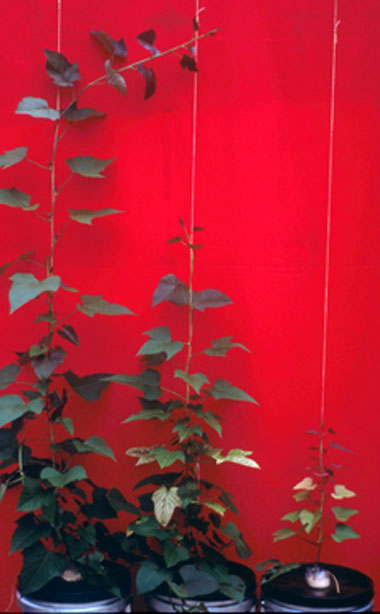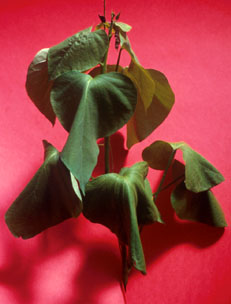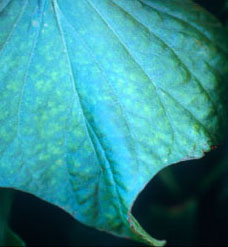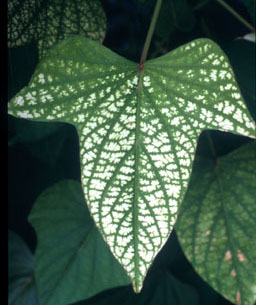|
Toxic
levels of copper (Cu) rarely occur naturally in soils. However, copper may
accumulate due to application of sewage sludge, pig slurries or mine slag, or
more commonly through persistent use of copper-containing fungicides or
fertilisers. Mild symptoms of copper toxicity have been observed on sweetpotato
in northern Australia on land with a history of heavy fungicide use.
Excess copper is highly toxic to sweetpotato, concentrations as low as 5 µM
in the root zone being sufficient to cause significant growth reduction.
Concentrations above 20 µM prevent root growth and result in the death of the
transplanted cutting. Root damage may cause severe wilting, and death of the
shoot tip. Unlike zinc toxicity, there is little or no general chlorosis of the leaves, nor increased red pigmentation.
Moderate levels of copper toxicity may be accompanied by a
pale green to white interveinal chlorosis
on mature leaves. Often the symptom appears on only a few leaves on
the vine, with both younger and older leaves lacking chlorosis. Small interveinal areas become pale and slightly sunken, while the tissue around both
major and minor veins retains normal colouration. The effect may vary from a
faint mottle to a striking, sharply defined pattern. The
symptom is often unevenly distributed across the blade, affecting one region,
such as the leaf tip or a lobe, more than others.
Like toxicities of manganese and zinc, copper toxicity may also induce symptoms of
iron deficiency, seen as a conspicuous pale yellow interveinal chlorosis on the
younger leaves.
The interveinal chlorosis may be confused with the pitting
caused by manganese deficiency. In the case of copper toxicity, it is most
intense on mature rather than on younger leaves and is not accompanied by a
general chlorosis of the leaf blade. Symptoms of manganese deficiency typically
affect the entire blade uniformly, while those of copper toxicity may be
localised or unevenly distributed.
It may be difficult to distinguish between severe copper
toxicity and zinc toxicity, although the latter more frequently causes increased
red pigmentation on the vines. Some knowledge of the site history and a chemical
analysis of leaf tissue may be necessary to confirm the diagnosis.
No soil tests have been calibrated for copper toxicity in
sweetpotato. For many crops, ‘total’ soil copper concentration (perchloric
acid extractable) above 100 mg/kg have been regarded as high (Landon, 1991),
while concentrations of DTPA-extractable copper above 20 mg/kg are potentially
toxic in acid soils (CFL, 1983). For citrus, soils containing more than 112
kg/ha total copper in the top 15 cm, using Spencer’s test (Spencer, 1954), are
considered at risk, particularly if the soil pH is below 6.5 (Koo et al.,
1984).
Copper toxicity appears to affect primarily the plant roots,
and therefore the concentration in the above-ground parts may be a poor
indicator of plant status. Alva et al. (1995) found no significant
increase in foliar copper concentrations in citrus trees, as soil copper was
increased to levels which decreased growth. In sweetpotato, critical tissue
concentration for toxicity of 15.5 mg copper/kg in the 7th to 9th youngest leaf
blades was determined in solution culture. However, analyses of healthy
field-grown plants have been found to commonly exceed this concentration. In
crops where no fungicides have been applied, concentrations above 30 mg
copper/kg have been recorded, while crops receiving fungicidal sprays may
contain much higher concentrations without ill effect. From the author’s
experience in Queensland, a concentration of 270 mg copper/kg was measured in
plants showing mild symptoms of copper toxicity, while over 800 mg copper/kg was
measured in leaves of an apparently healthy crop. These high concentrations are
probably achieved by direct adsorption of copper onto the leaf surfaces from
fungicidal spray, and reflect the recent spraying history of the crop. In
contrast, toxicity is more likely to result from accumulated spray residues in
the soil, and depends on the extended history of the site, combined with the
ability of the soil to fix copper.
Cultural control
As copper toxicity usually results from excessive application
of copper, prevention rather than correction should be stressed. Heavy
applications of P fertilisers may reduce the availability of excess copper to
the plants. Liming may be beneficial, as copper becomes less available to plants
at high pH. This strategy has been used effectively in citrus crops, where
maintaining the soil pH above 6.5 has been recommended for amelioration of
copper toxicity (Koo et al., 1984).
Alva, A.K., Graham, J.H. and Anderson, C.A. 1995. Soil pH and
copper effects on young ‘Hamlin’ orange trees. Soil Science Society of
America Journal 59, 481-487.
CFL 1983. Soil Analysis Service Interpretation Charts.
Consolidated Fertilizers Limited, Morningside, Queensland, Australia.
Koo, R.J.C., Anderson, C.A., Stewart, I., Tucker, D.P.H.,
Calvert, D.V. and Wutscher, H.K. 1984. Recommended fertilizers and nutritional
sprays for citrus. Bulletin 536D, Institute of Food and Agricultural Science,
University of Florida, Gainesville FL, USA.
O’Sullivan, J.N., Asher, C.J. and Blamey, F.P.C. 1997.
Nutrient Disorders of Sweet Potato. ACIAR Monograph No. 48, Australian Centre
for International Agricultural Research, Canberra, 136 p.
O’Sullivan, J., Loader, L., Asher, C., Blamey, P. 1997b.
Troubleshooting nutritional problems in a new industry: sweet potato in North
Queensland. Proceedings of the First Australian New Crops Conference, Gatton,
July 1996. Rural Industries Research and Development Corporation, Australia.
Spencer, W.F. 1954. A rapid test for possible excesses of copper
in sandy soils. University of Florida Agricultural Experiment Station Bulletin
No. 544.
Tiller, K.G. and Merry, R.H. 1981. Copper pollution of
agricultural soils. In: Loneragan, J.F. et al. (ed.) Copper in soils and
plants. Academic Press, North Ryde, NSW, Australia. pp 119-137.
Contributed
by:
Jane O'Sullivan |
Characteristics
and occurrence
Symptoms
Confusion
with other symptoms
Diagnostic
tests
Management
References

Growth reduction and chlorosis on mature leaves in nutrient solution with
trace, 8 µM, and 12 µM copper (L to R) (J.
O'Sullivan).

Wilting due to severe root damage (J.
O'Sullivan).

A mild mottling between veins of an old leaf, in a field where
copper-based fungicides had been frequently used (J.
O'Sullivan).

Whitening of areas between veins of a mature leaf (J.
O'Sullivan). |

